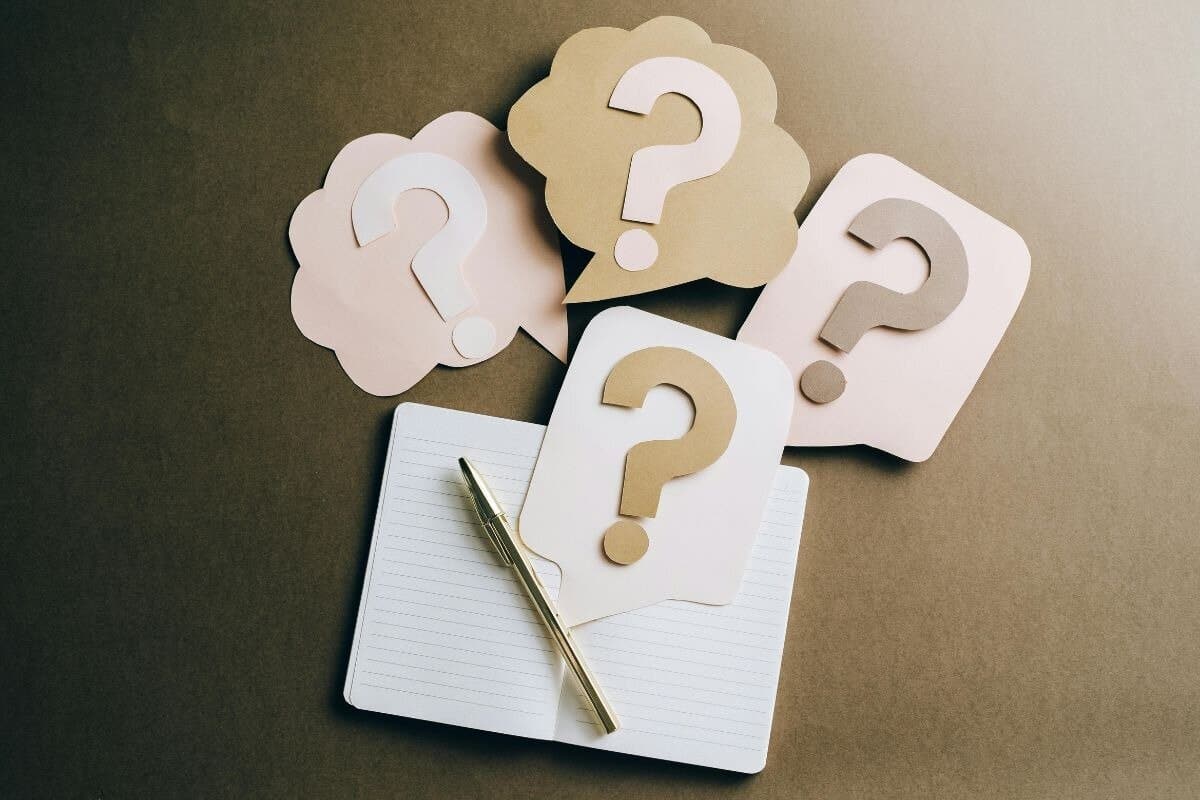Is punctuation part of the grammar?
Well, the answer is not a simple yes or no. But punctuation errors sure cost millions of dollars to a company.
In 1999, a comma cost Lockheed Martin $70 million. All because of a punctuation difference between American and European notation.
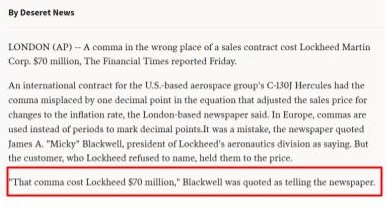
What does that mean?
At the time, Lockheed Martin’s aeronautics division president, James “Micky” Blackwell, believed his legal team had locked in a standard, airtight international contract for the C-130J Hercules aircraft.
The deal included a routine inflation adjustment clause. Business as usual.
But someone had made a microscopic yet catastrophic error in that document.
They used a comma instead of a decimal point in the price adjustment formula. Here’s the issue:
- American format: 3.14 (period = decimal)
- European format: 3,14 (comma = decimal)
That tiny cultural difference completely altered the math.
And in the eyes of the law, Lockheed was stuck with the price as written. The final damage was $70 million.
Roughly one-quarter of the company’s $275 million earnings hit for the C-130J program that year.
If you’re here, it means you’ve also got confusion: Is punctuation considered part of grammar?
In this blog, we’ll explore what grammar is, and what it doesn’t.
You’ll also learn whether punctuation, spelling, and capitalization fall under grammar, how punctuation errors can lead to legal and structural disasters, and so much more.
Let’s dive in.
Key Takeaways
- Is punctuation part of grammar? They’re not the same. Grammar is how language is structured; punctuation is how writing shows that structure.
- Experts disagree on punctuation’s role. Some say it’s part of grammar. Others say it’s just writing mechanics.
- Punctuation affects clarity. Wrong punctuation confuses meaning and grammar.
- Punctuation rules change by style guide. APA, MLA, and Chicago often give different punctuation rules. Grammar stays the same.
- Languages treat punctuation differently. What counts as punctuation or grammar varies by culture and writing system.
Punctuation, Grammar, Syntax: Where Do They Overlap?
Commas, sentence structure, and word order are not the same. These are three different systems that work together.
This understanding is crucial when considering whether is punctuation a part of grammar in different contexts.
Let’s start with their definitions:


Never Worry About AI Detecting Your Texts Again. Undetectable AI Can Help You:
- Make your AI assisted writing appear human-like.
- Bypass all major AI detection tools with just one click.
- Use AI safely and confidently in school and work.
- Grammar
It is the overall system of rules that govern how a language works. It includes:
- Parts of speech (nouns, verbs, adjectives, etc.)
- Verb conjugation and tense
- Subject-verb agreement
- Word order rules
- Pronoun usage
- Articles and determiners
- Modifiers and placement
- Active vs. passive voice
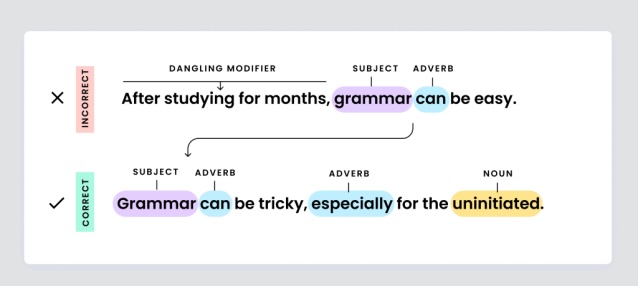
2. Syntax
Syntax is a subset of grammar that deals specifically with how words and phrases are arranged to form correct, meaningful sentences. It includes:
- Word order (e.g., Subject–Verb–Object in English)
- Sentence types (simple, compound, complex)
- Clause placement and hierarchy
- Coordination and subordination
- Parallel structure
- Sentence boundaries
3. Punctuation
Punctuation is not part of spoken language. It’s a visual system used in writing to guide how text is read and understood.
It supports the rhythm, structure, and logic that grammar and syntax create. It includes:
- End marks (periods, question marks, exclamation points)
- Commas (for lists, pauses, clauses)
- Quotation marks
- Colons and semicolons
- Parentheses, dashes, and ellipses
- Apostrophes (possession and contractions)
We’ve learnt the definitions, let’s see how these three overlap with each other. Look at this example:
“Let’s eat grandma” vs. “Let’s eat, grandma.”
- Grammar: Both sentences have proper parts of speech and correct subject-verb-object structure.
- Syntax: The word order is technically valid in both.
- Punctuation: The comma makes the entire difference in meaning—turning a statement from horrifying to harmless.
Now look at this example:
Incorrect: She writes the emails, she manages the budget.
This is both a punctuation mistake and a syntactic violation. Two full clauses incorrectly joined with just a comma.
Fixing it requires understanding both grammar (clause independence) and punctuation (how to join clauses).
Correct: She writes the emails, and she manages the budget.
Correct: She writes the emails. She manages the budget.
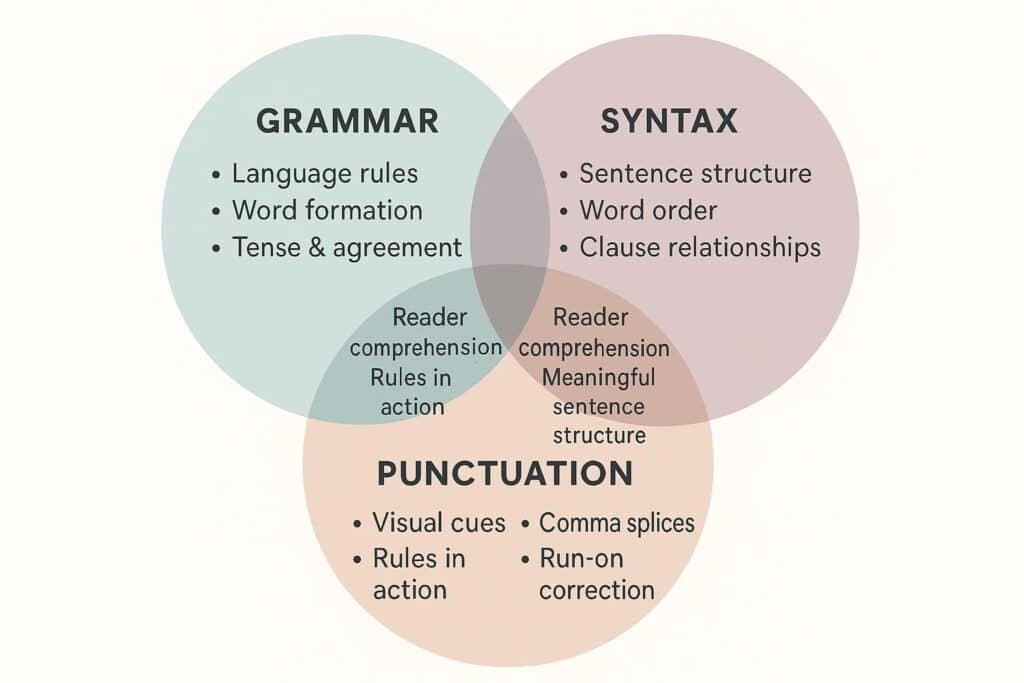
What Is Grammar?
Grammar is the set of rules that tells us how to use a language. It helps us make words, build sentences, and share our thoughts clearly whether we are talking, writing, or thinking.
When students ask is punctuation considered part of grammar, they’re often confused about where these writing mechanics fit within language structure.
- Traditional Definition (Morphology + Syntax)
Traditionally, grammar is made up of two main components: morphology and syntax.
| Aspect | Morphology | Syntax |
| Definition | Study of how words are built from smaller meaningful parts (morphemes). | Study of how words are arranged to form grammatically correct sentences. |
| Focus | Internal structure of words. | Sentence structure and word order. |
| What It Covers | PrefixesSuffixesRoot wordsWord transformations | Word order (e.g., SVO)Clause relationshipsSentence types (simple, compound, complex) |
| Examples | Unhappiness = un- + happy + -nessRewriting = re- + write + -ing | Correct: The cat sat on the mat.Incorrect: Sat the cat mat the on. |
| Explanation | Explains how words change form to express tense, meaning, or relationship. | Explains how word placement and sentence flow impact clarity and meaning. |
Also Read: What Is Grammar? Grammar Definition & Examples
- Grammar as the Rule System of Language
Grammar is a rule system that applies to both spoken and written language. And it’s in effect long before we ever put pen to paper.
For example, a child can say “I goed to the park” before they learn how to write. That’s a grammar error in verb tense, not a punctuation or spelling issue.
There are no punctuation or rules in spoken language. You feel pauses, tone, and rhythm, but the underlying structure is driven by grammar.
- What It Typically Excludes
Is spelling part of the grammar? Grammar is about the structure of language, not about visual or formatting choices. It does not include:
- Spelling (orthography)
- Capitalization conventions
- Punctuation marks
These elements deal with how language looks on the page, not how it’s structured in the mind or spoken aloud. Also excluded:
- Style choices: e.g., whether you use the Oxford comma or follow AP vs. Chicago style
- Formatting rules: like headline capitalization or indentation
What Is Punctuation?
Punctuation is the set of marks we use in writing to organize words, make meaning clear, and help the reader know how to read the sentence.
This clarifies why capitalization and punctuation is part of grammar.
- Definition of Punctuation in Written Language
At its core, punctuation is a technology. It is a system that was developed to reflect the natural pauses, emphasis, and patterns of spoken language in written form.
Historically, punctuation emerged as writing evolved. Early writing systems had no punctuation.
- Punctuation as a Writing Convention, Not Spoken
Punctuation only exists in writing. You can’t hear a comma, a period, or a dash.
In spoken language, we rely on prosody. Things like pitch, rhythm, pauses, and stress to shape meaning. Example:
Spoken:
- Let’s eat, Grandma.
- Let’s eat Grandma.
In speech, tone and timing show the meaning. In writing, punctuation does that job.
Many old languages like Latin, Greek, and Chinese had no punctuation. Texts were written with no spaces or marks, and readers had to know the content well.
Punctuation was added later to make reading easier. If you’re unsure whether something is a grammar rule or just punctuation, Ask AI using your own example, it can help clear things up.

- Common Punctuation Marks and Their Roles
To understand punctuation’s function, it helps to look at its categories and what each type does.
| Category | Punctuation Mark | Function | Example |
| End Punctuation | Period (.) | Ends a declarative sentence | She went home. |
| Question mark (?) | Ends a direct question | Where are you going? | |
| Exclamation point (!) | Expresses emotion or emphasis | Watch out! | |
| Internal Punctuation | Comma (,) | Separates items, clauses, or ideas | I bought apples, oranges, and bananas. |
| Semicolon (;) | Connects two closely related independent clauses | She was tired; she still finished the work. | |
| Colon (:) | Introduces lists, explanations, or quotes | He brought three things: a pen, a notebook, and a phone. | |
| Dash (-) | Adds emphasis or interruption | She finally understood—the answer was obvious. | |
| Quotation & Emphasis Mark | Quotation marks (“ “) | Indicate speech or quotations | He said, “I’ll be there soon.” |
| Parentheses ( ) | Add additional, nonessential information | She moved to Paris (her dream city) in 2020. | |
| Apostrophe (’) | Shows possession or forms contractions | Sarah’s book. / Don’t go. |
Also read: Punctuation Uses
Is Punctuation Part of Grammar? The Two Perspectives
So is punctuation part of grammar? It’s a common question with no single answer.
This is because the line between grammar and punctuation isn’t always clear, and depends on how we define each.
Here’s how the debate breaks down:
Perspective 1: Punctuation is NOT grammar
According to this perspective, punctuation should be considered under mechanics or orthography, which are the conventions of writing.
Key arguments are:
- Punctuation rules are not universal. Its rules change depending on the style guide you use such as AP, MLA, and Chicago often give different advice.
- Style vs. structure. For instance, the word “however” can appear at the beginning, middle, or end of a sentence. Grammar allows this flexibility. But whether a comma follows it depends entirely on style rules—not grammar rules.
This perspective supports the inclusion for the question: is punctuation considered part of grammar?
Example:
- However, she declined. (comma required by most style guides)
- She declined, however. (also correct, punctuation depends on tone and style)
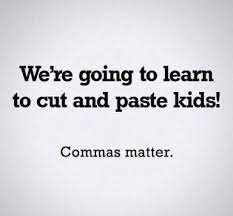
Perspective 2: Punctuation IS part of grammar
But punctuation also tells sentence structure and meaning, which puts it under grammar’s umbrella. Some punctuation errors are also grammatical.
Key arguments are:
- Some punctuation marks directly affect meaning, structure, and clause relationships.
- In written language, improper punctuation can cause grammatical ambiguity or outright errors.
Example:
- The children who played outside were noisy. (restrictive clause – specifies which children)
- The children, who played outside, were noisy. (non-restrictive clause – adds extra information)
A missing comma here doesn’t just break a punctuation rule, it changes the grammatical interpretation of the sentence.
The Role of Punctuation in Grammatical Clarity
We’ve been discussing how grammar and punctuation work together.
Now, here are five clear ways punctuation directly impacts grammatical clarity:
- Comma Splices
A comma splice is a grammatical error.
- Incorrect: I was late, I missed the bus.
- Correct: I was late, so I missed the bus.
- Correct: I was late. I missed the bus.
Punctuation here defines sentence boundaries. Without the right mark (or conjunction), the structure fails.
- Dangling Modifiers
Punctuation helps anchor modifiers to the correct subject. Missing punctuation can make a sentence imply something absurd.
- Incorrect: After eating John left.
- Correct: After eating, John left.
Without the comma, the sentence momentarily suggests that John was the one being eaten.
- Ambiguous Pronoun References
When reporting speech or referencing others, punctuation determines who said what, and how it should be interpreted.
- Incorrect: She said Jane is mean.
- Correct: She said, “Jane is mean.”
The first sentence lacks clarity: is it indirect speech or a paraphrase? The second provides syntactic certainty and preserves the speaker’s exact words.
- Phrasing Errors
Misplaced commas or missing punctuation often result in:
- Shifting grammatical subjects
- Unclear relationships between clauses
- Confused sentence rhythm and flow
- Clause Hierarchies
Punctuation determines how a sentence is parsed. What’s grouped together, what’s emphasized, and what’s optional.
Consider:
- Let’s eat Grandma. vs. Let’s eat, Grandma.
One is a gruesome command, the other a warm invitation.
The relationship between punctuation and grammar might be complex, but a Grammar Checker sure does help in catching punctuation mistakes that interfere with clarity and correctness.
Use the Grammar Checker here.
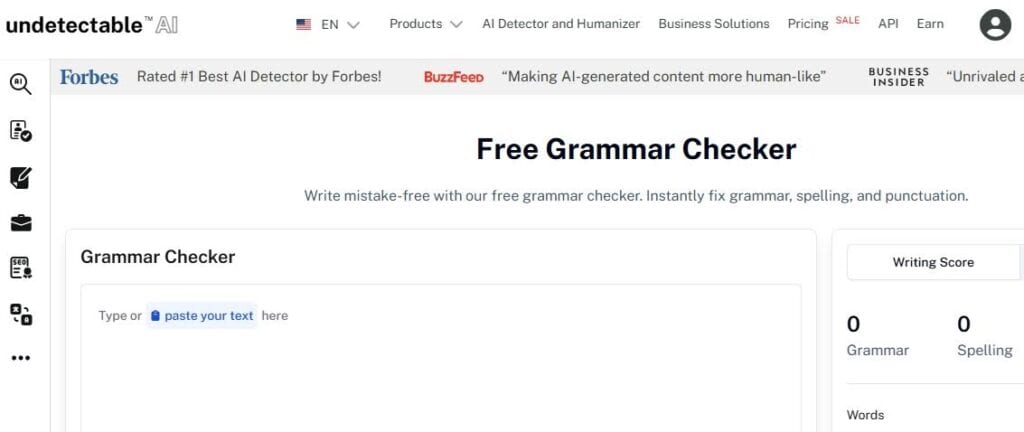
Grammar vs Mechanics vs Usage vs Style
Is capitalization and punctuation part of grammar? To write clearly and correctly, it’s important to understand how grammar, mechanics, usage, and style:
| Aspect | Definition | Examples | Function |
| Grammar | Core structural rules governing sentence formation | Subject-verb agreement: She walks vs. She walk | Defines correct sentence structure and syntax |
| Mechanics | Technical writing conventions like punctuation, spelling | Capitalization: i vs. IPunctuation: missing comma | Ensures clarity and readability in written language |
| Usage | Accepted word choices and idiomatic correctness | Less vs. fewer, who vs. whom | Maintains clarity and conforms to standard language norms |
| Style | Personal or institutional preferences in expression | Oxford comma, MLA vs. APA formatting | Guides tone, voice, formatting, More flexible and context-dependent |
Grammar errors are the most critical. Style issues, while still important, are subjective.
For students and ESL writers, mechanics (especially punctuation) can often blur into grammar mistakes, which affects clarity and correctness.
Use an AI Essay Rewriter to automatically revise punctuation-driven sentence structure issues and enhance overall clarity. It is especially helpful for academic and non-native writers.
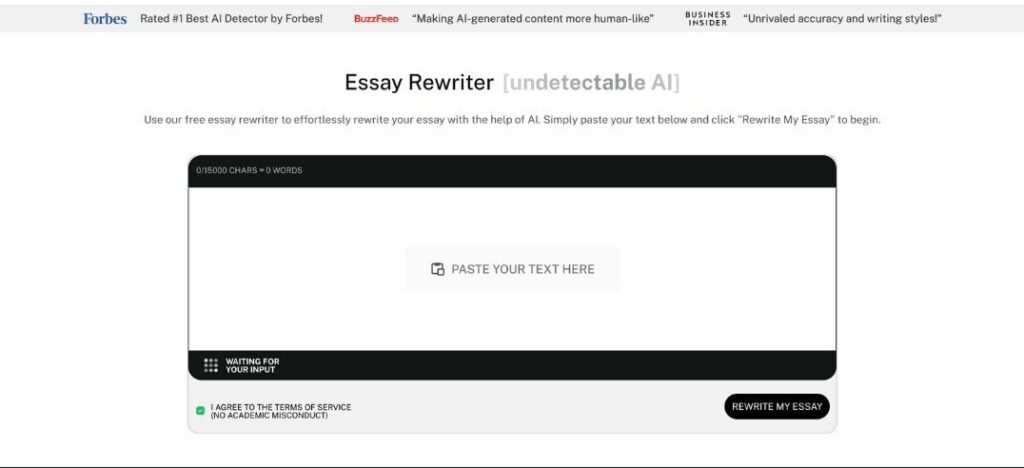
Punctuation in Different Languages
- Does Grammar Include Punctuation Universally?
Not always. Punctuation systems evolved separately from grammatical systems throughout history.
Punctuation is not considered as a grammatical requirement in many languages. For example:
- In English, punctuation is often taught as part of grammatical structure.
- In Chinese, punctuation was a relatively modern addition and still functions separately from traditional grammar.
This language variation complicates the question: is spelling part of grammar or punctuation?
- Cultural and Script-Based Differences
Different writing systems and cultural norms influence how punctuation is used and understood:
- Arabic: As a right-to-left language, Arabic punctuation mirrors the writing direction.
- For example, the comma (،) is inverted compared to the English form and appears on the left.
- For example, the comma (،) is inverted compared to the English form and appears on the left.
- Chinese: Utilizes full-width punctuation marks (e.g., 。,、) to align with character spacing.
- For example, Chinese also distinguishes between different types of commas, such as the enumeration comma (、) and the regular comma (,).
- For example, Chinese also distinguishes between different types of commas, such as the enumeration comma (、) and the regular comma (,).
- Japanese: With multiple writing systems (kanji, hiragana, katakana), punctuation use can differ by context.
- For example, The Japanese period (。) and comma (、) resemble Chinese but are applied within unique syntactic frameworks.
- For example, The Japanese period (。) and comma (、) resemble Chinese but are applied within unique syntactic frameworks.
- Spanish: Known for its inverted question (¿) and exclamation (¡) marks that point toward the tone from the beginning of a sentence.
- Examples from English vs Spanish vs Chinese
Let’s look at how a basic sentence might differ in punctuation across languages:
- English:
She said, “I’m going home.”
(Quotation marks placed outside the comma)
- Spanish:
Ella dijo: «Me voy a casa».
(Angle quotation marks, punctuation placed after the quote) - Chinese:
她说:“我要回家。”
(Full-width quotation marks and period inside the quote)
How to Teach Grammar and Punctuation Together
Trying to teach grammar and punctuation separately can leave students confused.
The better way is to teach them together because punctuation actually helps show how grammar works in a sentence.
- Connect the Dots
Punctuation helps show the structure of a sentence like where a clause ends or what part is extra information. Teach it as part of the grammar.
- Start with Sentence Basics
Teach how a sentence works first (like what’s a subject and verb). Once students get that, show them how punctuation fits in to make things clearer.
- Point Out Common Mistakes
Some of the most common writing mistakes happen where grammar and punctuation overlap, like:
- Using a comma where a period should go (comma splices)
- Leaving out commas and making the sentence confusing
- Putting modifiers in the wrong place and changing the meaning
Call these out when they happen and explain both the grammar issue and how punctuation can fix it.
- Test Them Separately
Sometimes students know the grammar but mess up the punctuation, or the other way around. When testing, try asking questions that check each skill on its own so you can tell where they need help.
- Use Sentence Combining
Take two short sentences and ask students to combine them in different ways using punctuation. Example:
- It was cold. We stayed inside.
- It was cold, so we stayed inside.
- It was cold—we stayed inside.
This shows how punctuation changes the flow and meaning.
Refine AI-written text for clarity and trust—use the AI Detector and Humanizer below.
Final Thoughts
Grammar gives structure. Punctuation gives clarity.
Together, they ensure your message is understood as intended.
Whether you’re drafting an email, writing a legal contract, or creating content for a global audience, knowing how punctuation fits within grammar matters.
Is punctuation a part of grammar?
Technically, they’re distinct, but deeply connected.
Mistakes in either can shift meaning, cause confusion, or worse, lead to serious consequences.
Respect both. Learn the rules.
With Undetectable AI’s Ask AI, AI Essay Rewriter, and AI Grammar Checker, you can quickly check for errors, restructure sentences, and ensure your punctuation works hand in hand with grammar.
And when in doubt, choose clarity over assumption.
Make writing easier and more polished—try Undetectable AI today.
